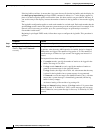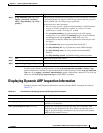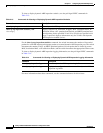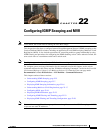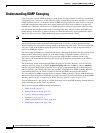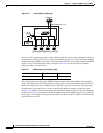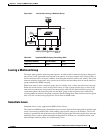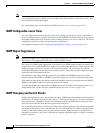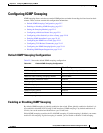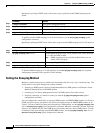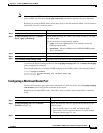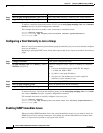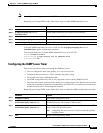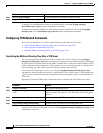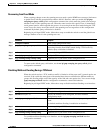
22-6
Catalyst 2960 and 2960-S Switch Software Configuration Guide
OL-8603-09
Chapter 22 Configuring IGMP Snooping and MVR
Understanding IGMP Snooping
Note You should only use the Immediate Leave feature on VLANs where a single host is connected to each
port. If Immediate Leave is enabled in VLANs where more than one host is connected to a port, some
hosts might inadvertently be dropped.
For configuration steps, see the “Enabling IGMP Immediate Leave” section on page 22-10.
IGMP Configurable-Leave Timer
You can configure the time that the switch waits after sending a group-specific query to determine if
hosts are still interested in a specific multicast group. The IGMP leave response time can be configured
from 100 to 5000 milliseconds. The timer can be set either globally or on a per-VLAN basis. The VLAN
configuration of the leave time overrides the global configuration.
For configuration steps, see the “Configuring the IGMP Leave Timer” section on page 22-11.
IGMP Report Suppression
Note IGMP report suppression is supported only when the multicast query has IGMPv1 and IGMPv2 reports.
This feature is not supported when the query includes IGMPv3 reports.
The switch uses IGMP report suppression to forward only one IGMP report per multicast router query
to multicast devices. When IGMP router suppression is enabled (the default), the switch sends the first
IGMP report from all hosts for a group to all the multicast routers. The switch does not send the
remaining IGMP reports for the group to the multicast routers. This feature prevents duplicate reports
from being sent to the multicast devices.
If the multicast router query includes requests only for IGMPv1 and IGMPv2 reports, the switch
forwards only the first IGMPv1 or IGMPv2 report from all hosts for a group to all the multicast routers.
If the multicast router query also includes requests for IGMPv3 reports, the switch forwards all IGMPv1,
IGMPv2, and IGMPv3 reports for a group to the multicast devices.
If you disable IGMP report suppression, all IGMP reports are forwarded to the multicast routers. For
configuration steps, see the “Disabling IGMP Report Suppression” section on page 22-15.
IGMP Snooping and Switch Stacks
IGMP snooping functions across the switch stack; that is, IGMP control information from one switch is
distributed to all switches in the stack. (See Chapter 7, “Managing Switch Stacks,” for more information
about switch stacks.) Regardless of the stack member through which IGMP multicast data enters the
stack, the data reaches the hosts that have registered for that group.
If a switch in the stack fails or is removed from the stack, only the members of the multicast group that
are on that switch will not receive the multicast data. All other members of a multicast group on other
switches in the stack continue to receive multicast data streams. However, multicast groups that are
common for both Layer 2 and Layer 3 (IP multicast routing) might take longer to converge if the stack
master is removed.



